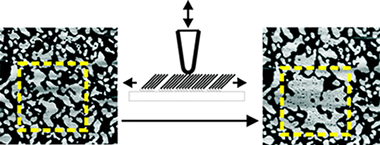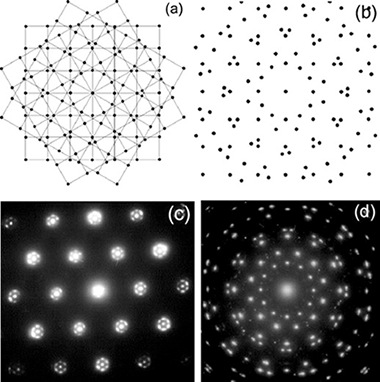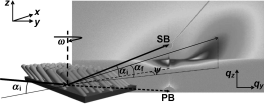Artículos SCI
2010
2010
Materiales Nanoestructurados y Microestructura
Influence of carbon chemical bonding on the tribological behavior of sputtered nanocomposite TiBC/a-C coatings
Abad, MD; Sanchez-Lopez, JC; Brizuela, M; Garcia-Luis, A; Shtansky, DVThin Solid Films, 518 (2010) 5546-5552
Show abstract ▽

The tribological performance of nanocomposite coatings containing Ti-B-C phases and amorphous carbon (a-C) are studied. The coatings are deposited by a sputtering process from a sintered TiB2:TiC target and graphite, using pulsed direct current and radio frequency sources. By varying the sputtering power ratio, the amorphous carbon content of the coatings can be tuned, as observed by X-ray photoelectron spectroscopy (XPS) and Raman spectroscopy. The crystalline component consists of very disordered crystals with a mixture of TiB2/TiC or TiBxCy phases. A slight increase in crystalline order is detected with the incorporation of carbon in the coatings that is attributed to the formation of a ternary TiBxCy phase. An estimation of the carbon present in the form of carbide (TiBxCy or TiC) and amorphous (a-C) is performed using fitting analysis of the C 1s XPS peak. The film hardness (22 to 31 GPa) correlates with the fraction of the TiBxCy phase that exists in the coatings. The tribological properties were measured by a pin-on-disk tribometer in ambient conditions, using 6 mm tungsten carbide balls at 1 N. The friction coefficients and the wear rates show similar behavior, exhibiting an optimum when the fraction of C atoms in the amorphous phase is near 50%. This composition enables significant improvement of the friction coefficients and wear rates (mu similar to 0.1; k < 1 x 10(-6) mm(3)/Nm), while maintaining a good value of hardness (24.6 GPa). Establishing the correlation between the lubricant properties and the fraction of a-C is very useful for purposes of tailoring the protective character of these nanocomposite coatings to engineering applications.
Julio, 2010 | DOI: 10.1016/j.tsf.2010.04.038
Materiales de Diseño para la Energía y Medioambiente
Steering the Self-Assembly of Octadecylamine Monolayers on Mica by Controlled Mechanical Energy Transfer from the AFM Tip
Benitez, JJ; Heredia-Guerrero, JA; Salmeron, MJournal of Physical Chemistry C, 114 (2010) 12630-12634
Show abstract ▽

We have studied the effect of mechanical energy transfer from the tip of an atomic force microscope on the dynamics of self-assembly of monolayer films of octadecylamine on mica. The formation of the self-assembled film proceeds in two successive stages, the first being a fast adsorption from solution that follows a Langmuir isotherm. The second is a slower process of island growth by aggregation of the molecules dispersed on the surface. We found that the dynamics of aggregation can be altered substantially by the addition of mechanical energy into the system through controlled tip surface interactions. This leads to both the creation of pinholes in existing islands as a consequence of vacancy concentration and to the assembly of residual molecules into more compact islands.
Julio, 2010 | DOI: 10.1021/jp102813s
Nanotecnología en Superficies y Plasma
Preparation and structural properties of YBCO films grown on GaN/c-sapphire hexagonal substrate
Chromik, S; Gierlowski, P; Spankova, M; Dobrocka, E; Vavra, I; Strbik, V; Lalinsky, T; Sojkova, M; Liday, J; Vogrincic, P; Espinos, JPApplied Surface Science, 256 (2010) 5618-5622
Show abstract ▽

Epitaxial YBCO thin films have been grown on hexagonal GaN/c-sapphire substrates using DC magnetron sputtering and pulsed laser deposition. An MgO buffer layer has been inserted between the substrate and the YBCO film as a diffusion barrier. X-ray diffraction analysis indicates a c-axis oriented growth of the YBCO films. Φ-scan shows surprisingly twelve maxima. Transmission electron microscopy analyses confirm an epitaxial growth of the YBCO blocks with a superposition of three a–b YBCO planes rotated by 120° to each other. Auger electron spectroscopy and X-ray photoelectron spectroscopy reveal no surface contamination with Ga even if a maximum substrate temperature of 700 °C is applied.
Julio, 2010 | DOI: 10.1016/j.apsusc.2010.03.035
Nanotecnología en Superficies y Plasma
Structure of Glancing Incidence Deposited TiO2 Thin Films as Revealed by Grazing Incidence Small-Angle X-ray Scattering
Gonzalez-Garcia, L; Barranco, A; Paez, AM; Gonzalez-Elipe, AR; Garcia-Gutierrez, MC; Hernandez, JJ; Rueda, DR; Ezquerra, TA; Babonneaum, DChemphyschem, 11 (2010) 2205-2208
Show abstract ▽

For the first time, grazing incidence small-angle X-ray scattering (GISAXS) analysis is used to characterize the Morphology of TiO2 thin films grown by glancing angle physical vapor deposition (GLAD). According to cross-section scanning electron microscopy (SEM) images, the films consist of near isotilted TiO2 columns of different length and width depending on film thickness. The obtained GISAXS patterns show a characteristic asymmetry with respect to the incidence plane, which is associated with the titled of the TiO2 columns. The patterns also show the existence of two populations of columns in these GLAD TiO2 films. The population of the thinnest columns appears related to the first grown layer and is common for all the films investigated, while the second population of columns grows with the thickness of the films and has been related to wider columns formed by shadowing at the expense of the initially formed columns.
Julio, 2010 | DOI: 10.1002/cphc.201000136
Nanotecnología en Superficies y Plasma
Improved wear performance of ultra high molecular weight polyethylene coated with hydrogenated diamond like carbon
Puertolas, JA; Martinez-Nogues, V; Martinez-Morlanes, MJ; Mariscal, MD; Medel, FJ; Lopez-Santos, C; Yubero, FWEAR, 269 (2010) 458-465
Show abstract ▽

Hydrogenated diamond like carbon (DLCH) thin films were deposited on medical grade ultra high molecular weight polyethylene (UHMWPE) by radio frequency plasma enhanced chemical vapor deposition. The DLCH coating thicknesses ranged from 250 to 700 nm The substrates were disks made of UHMWPEs typically used for soft components in artificial Joints, namely virgin GUR 1050 and highly crosslinked (gamma irradiated in air to 100 kGy) UHMWPEs Mechanical and tribological properties under bovine serum lubrication at body temperature were assessed on coated and uncoated polyethylenes by means of nano-hardness and ball-on-disk tests, respectively Morphological features of the worn surfaces were obtained by confocal microscopy and scanning electron microscopy This study confirms an increase in surface hardness and good wear resistance for coated materials after 24 h of sliding test compared to uncoated polyethylene. These results point out that to coat UHMWPE with DLCH films could be a potential method to reduce backside wear in total hip and knee arthroplasties.
Julio, 2010 | DOI: 10.1016/j.wear.2010.04.033
- ‹ anterior
- 375 of 422
- siguiente ›














